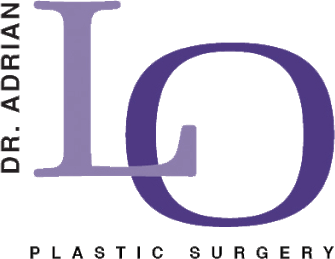Your breast augmentation journey is an exciting journey with decisions that need to be made to help you achieve the natural, beautiful results you envision. An important decision is considering the types of implants available and what is the best option for you.
Modern breast implants offer many possibilities. From the versatility of saline to the natural feel of silicone, each option brings unique advantages. Understanding the differences between the various types of implants will help you make the decision on which implant to choose to help you achieve the best look possible that complements your lifestyle.
Understanding the different types of implants empowers you to make the best decision for your unique situation and aesthetic goals.
Overview of Breast Augmentation Implants
Breast implants have evolved significantly over the past several decades. Today’s implants offer improved safety profiles and more natural-looking results. The FDA has approved multiple breast implants types for use in cosmetic breast implant surgery. Each option provides unique benefits and considerations.
There are two main types of implants: saline and silicone. Both have a silicone shell on the outside. The difference is in the filling. Saline implants are filled with sterile salt water. Silicone implants are filled with a thick silicone gel and are known as the ‘gummy bear’ implants. In an implant materials comparison, your plastic surgeon can explain the differences between saline and silicone to help you decide which option best fits your needs.
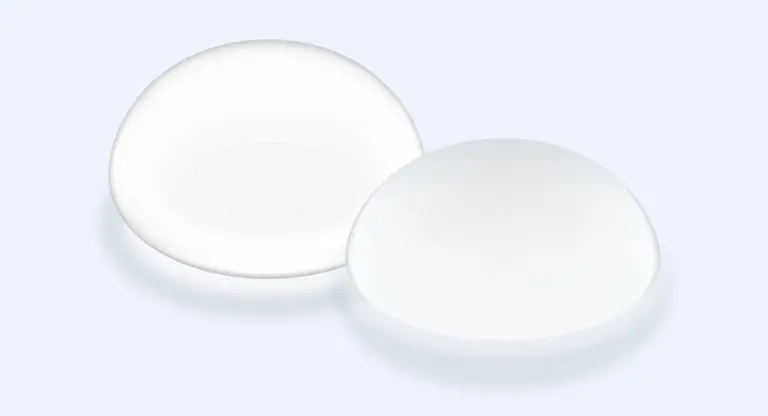
Importance of Choosing the Right Breast Implant
Selecting appropriate implants impacts both the appearance and longevity of your results.
Several factors influence implant selection:
- Your existing breast tissue plays a major role – women with minimal natural breast tissue may benefit from using a silicone vs. a saline implant
- Your lifestyle and activity level are important – some implants, such as cohesive silicone implants, may be better suited for active individuals
Your body proportions guide the implant size and shape recommendations. A skilled plastic surgeon evaluates your chest width, height and existing breast measurements. This assessment helps determine which cosmetic implant options will create the most harmonious result with your frame.
Understanding Your Goals and Expectations
Clear communication about your desired outcome is important. Some patients want a small enhancement that looks completely natural. Others prefer a more dramatic change in size and projection. Your goals influence which types of implants will best serve your needs.
Realistic expectations are important for satisfaction with your results. Breast implants can create beautiful, natural-looking enhancements when properly selected and placed. It is important to note that breast implants do not correct natural breast shape asymmetry between the right and left breast. Breast implants increase the size of your existing breasts. For example, if your nipples point in different directions before the surgery, they will continue to point in different directions after the surgery. A good way to think of this is to consider your breasts as ‘sisters’ and not ‘twins’.
Saline Implants: Features and Benefits
Saline implants were the primary option available in the United States for many years. These implants contain sterile saltwater solution inside a silicone shell. The FDA has approved saline implants for women age 18 and older for cosmetic breast augmentation.
Saline implants are filled during surgery after placement. This allows for adjustments in size during the procedure. The ability to fine-tune the volume can help achieve better symmetry between both breasts.
Composition and Structure of Saline Implants
The outer shell of saline implants consists of solid silicone elastomer. This durable material has been used safely in medical devices for decades. The shell contains multiple layers to prevent rupture and maintain structural integrity.
The saline solution inside these implants is identical to the fluid naturally found in your body. If a saline implant ruptures, your body safely absorbs the leaked fluid. This eliminates concerns about foreign substances remaining in your system.
The implant fill valve allows for volume adjustment during surgery. Your plastic surgeon can add or remove small amounts of saline to achieve the desired size and symmetry. This flexibility can be particularly beneficial for patients with pre-existing asymmetry.
Advantages of Saline Implants
Saline implants offer several benefits that make them appealing to many patients. The smaller incision required for insertion stands as one advantage. Since saline implants are filled after placement, they can be inserted through a smaller opening than pre-filled silicone implants.
Saline implants are often used when a large breast augmentation is desired. Saline implants are available in larger sizes than silicone implants.
Key advantages include:
- Cost considerations often favor saline implants as saline implants typically cost less than silicone alternatives. The lower initial investment can make breast augmentation more accessible.
- Detection of implant rupture is straightforward with saline implants. When a saline implant fails, the breast deflates noticeably within hours or days. This obvious change allows for prompt detection without requiring special imaging studies.
The safety profile of saline implants provides peace of mind for many patients. The biocompatible saline solution does not cause harm if rupture occurs. Your body naturally absorbs the leaked fluid harmlessly through normal physiological processes.
Considerations and Disadvantages
Saline implants may feel less natural than silicone alternatives, particularly in women with minimal existing breast tissue. The saline solution has different physical properties than natural breast tissue. Some patients notice the implant edges or experience rippling or wrinkling, especially when leaning forward.
The risk of visible rippling remains higher with saline implants. This wrinkling of the implant shell can sometimes be seen or felt through the skin. Patients with thin skin or minimal breast tissue coverage are more susceptible to this issue.
Silicone Implants: Features and Benefits
Silicone gel implants represent the most popular choice for breast augmentation today. These implants contain cohesive silicone gel that closely mimics the feel of natural breast tissue. The FDA has approved silicone implants for women age 22 and older for cosmetic breast augmentation.
Modern silicone implants use highly cohesive gel that maintains its shape even if the shell is damaged. This “gummy bear” consistency reduces the risk of gel migration if rupture occurs. The gel stays together rather than spreading throughout the breast capsule.
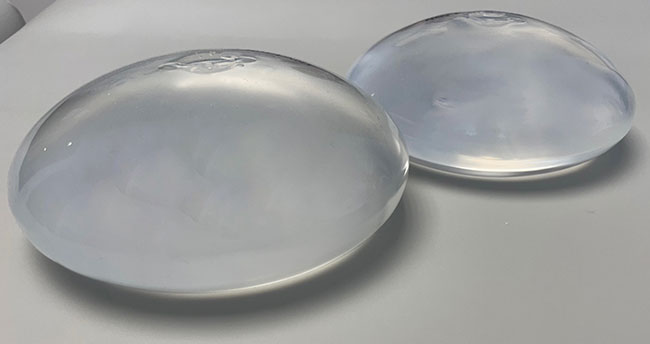
Highly Cohesive Silicone Gel Explained
The silicone gel used in today’s implants differs significantly from older formulations. Highly cohesive gel has a firmer consistency that holds together as a single unit. A good analogy would be gummy bear candy. If you cut a gummy bear candy in half, the pieces maintain their shape rather than flowing like liquid.
This cohesive property provides important safety benefits. If the implant shell develops a tear, the gel typically remains in place rather than dispersing within the breast capsule. This containment reduces the likelihood of gel spreading to surrounding tissues.
The cross-linking of silicone molecules creates the cohesive property. Manufacturers control the degree of cross-linking to achieve different gel consistencies. Softer gels feel more natural but are less cohesive. Firmer gels hold their shape better but may feel less natural.
Benefits of Silicone Gel or Gummy Bear Implants
Silicone implants typically provide the most natural look and feel. The gel consistency closely resembles natural breast tissue density. Most patients cannot distinguish between the augmented breast and natural tissue when silicone implants are properly placed.
Benefits of silicone implants include:
- Lower rate of visible rippling makes silicone implants attractive to many patients
- The cohesive gel fills the implant shell completely, reducing the formation of wrinkles or folds
- This advantage remains particularly important for patients with minimal existing breast tissue
Silicone implants maintain their shape consistently over time. The cohesive gel resists deformation and returns to its original form after compression. This shape retention helps preserve the aesthetic result for many years.
Patient satisfaction rates are typically high with silicone implants. Studies consistently show that women choose silicone implants again if revision surgery becomes necessary. This preference reflects the natural feel and appearance these implants provide.
Myths and Facts About Silicone Implants
Concerns about silicone implant safety have been disproven by extensive research conducted by the American Society of Plastic Surgeons and FDA studies. Large-scale studies involving hundreds of thousands of patients have demonstrated reasonable assurance of safety of modern silicone implants. These studies track patients for decades to monitor long-term outcomes.
The link of silicone implants and certain autoimmune diseases has been and continues to be thoroughly investigated. At this time, multiple independent research studies from the Institute of Medicine found no conclusive evidence of increased risk of connective tissue disorders or other autoimmune conditions in women with silicone implants.
Key facts about silicone implant safety:
- Silicone implants have not shown to increase cancer risk according to FDA data
- Comprehensive studies show no raised rates of breast cancer or other malignancies
- Regular mammography screening remains important and is not affected by implant presence
Shape of Breast Implants
Breast implants are available in different shapes to accommodate various aesthetic goals and body types. The two primary shapes are round and teardrop (anatomical). Each shape creates a different breast profile and appearance.
Round implants have been the standard for many years. They provide fullness in both the upper and lower portions of the breast. Teardrop implants offer a more graduated fullness that some patients prefer for a natural appearance.
Round Implants: Advantages and Usage
Round implants create consistent fullness throughout the breast. The symmetrical shape provides equal projection in all directions from the center point. This design works well for patients who want enhanced cleavage and upper breast fullness.
Advantages of round implants:
- Placement is less technique-sensitive than anatomical shapes
- Since round implants look the same from any angle, rotation does not affect the aesthetic outcome
- This characteristic simplifies the surgical procedure and reduces rotational risks
- Round implants often cost less than anatomical alternatives
The simpler manufacturing process and higher volume production keep costs lower. This price difference can make breast augmentation more affordable for some patients.
Most plastic surgeons have extensive experience with round implants. The long history of use means plastic surgeons understand how these implants behave and age over time. This experience contributes to predictable outcomes and patient satisfaction.
Teardrop Implants: Current Use and Availability
Teardrop or anatomical implants have a tapered shape that resembles a natural breast profile. These implants are fuller at the bottom and gradually taper toward the top. Some patients prefer this shape for a more natural-looking result.
The availability of teardrop implants has changed in recent years. Certain manufacturers have discontinued their anatomical implant lines due to concerns about textured surfaces. Current options for teardrop implants are more limited than in the past.
Teardrop implants require precise positioning during surgery. The implant must be oriented correctly to achieve the intended shape. If the implant rotates after surgery, the breast shape can appear distorted and may require surgical correction.
Historical Overview of Shape Preferences
Patient preferences for implant shape have evolved over time. In the 1990s and early 2000s, many patients preferred the more natural look of teardrop implants. Marketing emphasized the benefits of anatomical shapes for achieving natural results.
Recent trends show renewed interest in round implants. Advances in surgical techniques allow plastic surgeons to create natural-looking results with round implants. The versatility and reliability of round implants appeal to both patients and surgeons.
Social media and celebrity influence have also shaped breast implant preferences. Many patients prefer the fuller, rounder look that round implants provide. This aesthetic preference has contributed to the popularity of round implants in recent years.
Surface Texture Options for Breast Implants
Breast implants are available with different surface textures. The three main categories are smooth, textured, and micro-textured surfaces. Each texture type has different characteristics that affect how the implant interacts with surrounding tissue.
Surface texture influences how the implant settles and integrates with your body. Smooth implants move freely within the breast pocket. Textured surfaces encourage tissue adherence to reduce implant movement.
Smooth Implants: Benefits and Preferences
Smooth implants have a soft, even surface without texture or pillar projections. These implants move naturally within the breast pocket, similar to how natural breast tissue moves. The freedom of movement contributes to a natural feel and appearance.
Key benefits of smooth implants:
- Lower risk of certain complications makes smooth implants attractive to many patients and plastic surgeons
- Smooth implants have not been associated with anaplastic large cell lymphoma (ALCL), a rare condition linked to certain textured implants
- Smooth implants feel softer and more natural to most patients
The unrestricted movement within the breast pocket allows the implant to conform to body position changes. This mobility contributes to natural breast movement during activities.
Patient satisfaction with smooth implants remains consistently high. The combination of safety, natural feel, and aesthetic results makes smooth implants the preferred choice for many patients and plastic surgeons.
Textured Implants: Usage in Europe vs. USA
Textured implants were developed to reduce capsular contracture and implant displacement. The textured surface encourages tissue ingrowth that holds the implant in position. This adherence can prevent rotation and maintain shape consistency.
Usage patterns differ significantly between Europe and the United States:
- European plastic surgeons historically used textured implants more frequently than their American counterparts
- Different regulatory environments and clinical preferences contributed to the popularity of textured implants in certain countries
- Recent safety concerns have changed textured implant availability
- Some textured implants have been associated with increased ALCL risk
Regulatory agencies in various countries have restricted or banned certain textured implant types. The future of textured implants remains uncertain. Ongoing research continues to evaluate the safety and benefits of different surface textures. Patient and plastic surgeon preferences are shifting toward smooth implants in many markets.
Micro-Textured Implants: An Overview of Motiva
Micro-textured implants represent a newer category with subtle surface modifications. These implants have less pronounced texturing than traditional textured implants but more surface variation than completely smooth implants.
Motiva implants feature proprietary micro-texturing technology. The manufacturer claims this surface provides benefits of both smooth and textured implants while minimizing disadvantages. Clinical data continues to accumulate regarding long-term outcomes.
The availability of micro-textured implants varies by geographic region. Regulatory approval processes differ between countries, affecting when and where these implants become available. Patients interested in micro-textured options should discuss availability with their plastic surgeon.
Physical Characteristics of Breast Implants
The physical dimensions of breast implants significantly affect the final aesthetic result. Key measurements include base diameter, projection, and volume. Understanding these characteristics helps in selecting implants that complement your body proportions.
Proper sizing requires careful evaluation of your existing breast measurements and desired outcome. Your plastic surgeon will assess your chest dimensions and recommend appropriate implant characteristics to achieve your goals.
Understanding Base Diameter Measurements
Base diameter refers to the width of the implant at its widest point. This measurement determines how much of your chest wall the implant will cover. The base diameter must be appropriate for your natural breast width to avoid an unnatural appearance.
Choosing the correct base diameter is important for long-term results. An implant that is too wide for your frame can create an artificial look. An implant that is too narrow may not provide adequate coverage or enhancement.
Your natural breast width largely determines the appropriate base diameter range. Most patients achieve the best results when the implant base diameter closely matches their natural breast footprint. Slight variations may be acceptable depending on your goals.
Importance of Projection in Breast Implants
Projection describes how far the implant extends forward from the chest wall. Different projection levels are available to accommodate various body types and aesthetic preferences. Low, moderate, and high projection options allow for customization.
Your existing breast tissue and desired outcome influence projection selection. Patients with minimal natural breast tissue may benefit from higher projection implants. Those with adequate existing tissue may prefer moderate projection for a natural look.
The relationship between volume and projection affects implant selection. Higher projection implants can achieve greater forward projection with smaller volumes. This relationship allows for customization based on your specific proportions and goals.
Choosing the Right Dimensions for Individual Body Types
Successful breast implant selection requires matching dimensions to your unique anatomy. Your chest width, height, and existing breast characteristics all influence the ideal breast implant specifications.
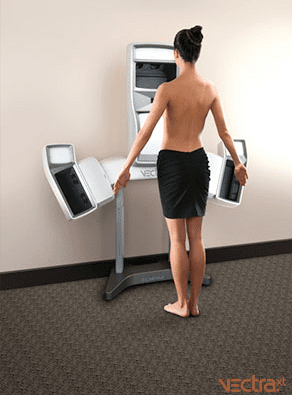
Three dimensional computer imaging using devices, such as the Vectra, and measurement tools help predict outcomes with different implant options. These technologies allow you to visualize potential results before making final decisions. However, the experience and judgment of your plastic surgeon assessing your physical anatomy, lifestyle and goals remain most important.
Trial sizing during consultation can provide valuable insights. External sizers with a bra allow you to experience different volumes and projections while clothed. This hands-on approach helps bridge the gap between measurements and personal preferences on your desired look.
Factors to Consider When Choosing Breast Implants
Selecting the right implants involves evaluating multiple factors specific to your situation. Your anatomy, lifestyle, goals, and preferences all play important roles in the decision-making process. Taking time to consider all relevant factors leads to better outcomes and higher satisfaction.
Assessing Body Types and Personal Preferences
Your natural body proportions provide the foundation for breast implant selection. Narrow-framed patients typically need different implant characteristics than broader-framed individuals. Height, weight, and existing breast tissue all influence appropriate breast implant choices.
Personal considerations that influence implant selection:
- Lifestyle considerations affect implant selection decisions
- Active patients may prefer certain implant types over others
- Professional requirements or personal clothing preferences may also influence your choice
- Personal aesthetic preferences guide many selection decisions
Some patients want dramatic enhancement while others prefer subtle changes. Your preference for cleavage, upper breast fullness, and overall breast shape influences implant recommendations.
Age-related factors may affect long-term satisfaction with different implant types. Younger patients may prioritize different characteristics than older patients. Considering how your preferences might change over time helps guide selection decisions.
Evaluating Risks vs. Benefits
All breast implants come with risks and benefits. Knowing both can help you make smart choices about your surgery. Your plastic surgeon will discuss with you the risks and benefits of implants for each type.
Some risks happen with any implant, like capsular contracture, implant rupture, or infection. But the chances and effects can be different between saline and silicone implants.
Different types of implants also need different long-term care. Silicone implants require regular radiologic follow-up such as mammograms to assess their integrity. Saline implants may be monitored clinically and do not require mammogram follow-up to assess integrity. Knowing this ahead of time helps you prepare for future care.
Consulting with a Qualified Plastic Surgeon
Choosing an experienced, board-certified plastic surgeon is important for optimal results.
During consultation, your plastic surgeon evaluates your anatomy and discusses your goals. This assessment includes measurements, tissue evaluation, and discussion of various implant options. The consultation process helps narrow down the best choices for your situation.
Multiple consultation visits may be beneficial for complex decisions. Taking time to consider different options and asking questions leads to more confident decision-making. Your plastic surgeon should encourage thorough evaluation and never pressure you to make quick decisions.
Post-Procedure Recovery and Care
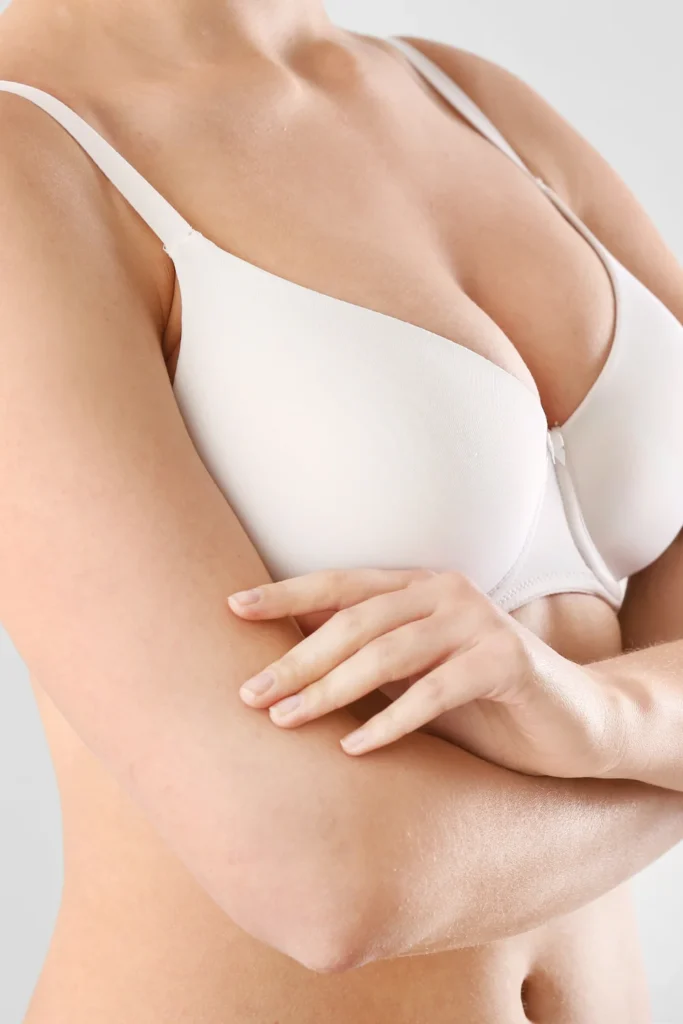
Recovery from breast augmentation follows predictable patterns regardless of implant type. However, certain aspects of recovery may vary slightly depending on your chosen implants. Understanding what to expect helps you prepare for a smooth recovery process.
Proper post-operative care contributes significantly to optimal healing and results. Following your plastic surgeon’s instructions carefully reduces complication risks and promotes the best possible outcome.
Expected Recovery Timeline After Surgery
The first week after surgery typically involves the most discomfort and activity restrictions. Most patients return to desk work within a few days to one week. Physical limitations gradually decrease as healing progresses.
Full recovery usually takes several weeks. Most patients resume normal activities within 2 to 4 weeks after surgery. Strenuous exercise and heavy lifting restrictions typically may start 3 to 4 weeks after surgery..
Implant settling is a normal part of the recovery process. Your breasts will continue to evolve and continue to improve their look for several months after surgery. The final result typically becomes apparent 3 to 6 months after your procedure.
Managing Pain and Discomfort
Pain management strategies help ensure comfortable recovery. Prescription pain medication may be needed for the first few days after surgery. Over-the-counter medications often provide adequate relief as healing progresses. Dr. Lo has a No Pain Protocol for his patients, who typically have very little pain after surgery.
Ice application can help reduce swelling and discomfort during the first few days. Your plastic surgeon will provide specific instructions about ice use and other comfort measures. Following these guidelines promotes healing and reduces complications.
Gradual activity increases help minimize discomfort while promoting healing. Starting with gentle movements and slowly increasing activity levels prevents setbacks. Listening to your body and avoiding overexertion is important during recovery.
Long-Term Maintenance of Breast Implants
Breast implants are not lifetime devices and may require replacement eventually. The timing varies between individuals and implant types. Regular follow-up with your plastic surgeon helps monitor implant condition and overall breast health.
Mammography screening remains important after breast augmentation. Special techniques may be needed to ensure adequate breast tissue visualization. Inform your mammography technician about your implants before screening.
Being aware of changes in your breasts helps identify potential issues early. Contact your plastic surgeon if you notice unusual pain, swelling, or changes in breast shape or size. Early detection and treatment of problems leads to better outcomes.
Get Help with Your Breast Augmentation Journey
Choosing the right types of implants for your breast augmentation represents a significant decision that impacts both your appearance and long-term satisfaction. The wide range of cosmetic implant options available today allows for highly personalized results that complement your unique anatomy and aesthetic goals.
Dr. Adrian Lo brings extensive experience and expertise to help guide you through the implant selection process. During your consultation, he will evaluate your anatomy, discuss your goals, and explain the various breast implants types available to you.
Contact us today to schedule your comprehensive breast augmentation consultation. Take the first step toward achieving the enhanced appearance you desire with the guidance of an experienced, board-certified plastic surgeon who prioritizes your safety and satisfaction.
